Remembering, Recognising and Responding: 21 years of the Anwernekenhe Aboriginal and Torres Strait Islander response to HIV
Remembering, Recognising and Responding: 21 years of the Anwernekenhe Aboriginal and Torres Strait Islander response to HIV
HIV Australia | Vol. 13 No. 3 | December 2015
Under the line “HIV Australia | Vol. 13 No. 3 | December 2015” can we please add:
Aboriginal and Torres Strait Islander people are advised that this article of HIV Australia contains names of people who have passed away.
By Michael Costello-Czok and Neville Fazulla
‘We recognise HIV/AIDS as a major health care threat to Aboriginal and Torres Strait Islander people. We also recognise and acknowledge Aboriginal and Torres Strait Islander Australians are dying alone and in shame of AIDS. This must stop’.1
This statement, made in 1994 by Aboriginal and Torres Strait Islander gay men and sistergirls attending Anwernekenhe 1 – First National Aboriginal and Torres Strait Islander Gay Men and Transgender Sexual Health Conference, mobilised a community response to HIV and set the foundations of the Anwernekenhe movement.
The Anwernekenhe 1 gathering, held at Hamilton Downs on Arrernte Country, just outside of Alice Springs, took place over four days from October 31 to November 4, 1994.
The conference brought together 73 participants from across Australia who together formulated 45 recommendations (refined down from over 100 recommendations from participants), as an urgent call to action.
At the completion of the conference, Arrernte Elders named the meeting Anwernekenhe, which translates as ‘Us Mob’ in Arrernte language.
Anwernekenhe 1 is now recognised as a key milestone in the Aboriginal and Torres Strait Islander led-response to HIV.
There have now been six Anwernekenhe conferences, and to mark 21 years since the inaugural 1994 meeting, Anwernekenhe 6 – held in November 2015 – saw the conference return to its original location in Alice Springs.
Twenty-one years on, the key recommendations from the 1994 conference still enshrine the core objectives of the Aboriginal and Torres Strait Islander response to HIV: ‘Us mob stronger together, working to stop HIV for our people and our country’.2
Advocacy and activism – the early years
In the early days of the HIV response in Australia, many Aboriginal and Torres Strait Islander gay men and sistergirls considered themselves to be invisible as a priority group.
Misconceptions about homosexuality in Aboriginal and Torres Strait Islander culture, compounded with limited understanding of HIV risk factors and infection, resulted in discrimination and isolation.
Community concern about the impact of HIV/AIDS among the Aboriginal gay population in the early 1980s saw a support network established by a group of openly gay Aboriginal men that included Rodney Junga-Williams, Malcolm Cole, Mathew Cook, Luke Close and John Cross.
In 1992, the First National Aboriginal HIV/AIDS Conference was held. This conference identified an urgent need to better understand and respond to the HIV/AIDS issues for gay men and sistergirls.
In April 1994, following a meeting of national HIV/AIDS educators in Sydney, John Cross, who was working as the Gay Men’s Peer Educator at Central Australian Aboriginal Congress (Alice Springs), with assistance from Phil Walcott from the AIDS Council of Central Australia, collaborated to prepare a successful funding submission to the Commonwealth to develop a national conference specifically addressing the impact of HIV in the Aboriginal and Torres Strait Islander gay and sistergirl community.3
Shortly after, in June 1994, a National Steering Committee was established to guide and oversee conference planning.
Anwernekenhe 1:
31 October – 4 November 1994
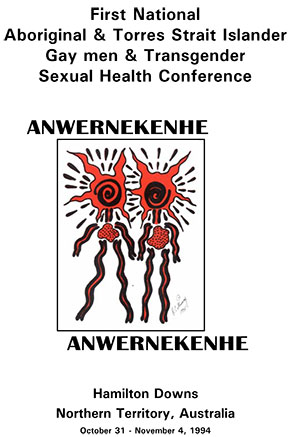 Unlike recent Anwernekenhe conferences, held in city conference centres with all the trappings, Anwernekenhe 1 took place in the open air at Hamilton Downs, Alice Springs.
Unlike recent Anwernekenhe conferences, held in city conference centres with all the trappings, Anwernekenhe 1 took place in the open air at Hamilton Downs, Alice Springs.
Read excerpts from Neville Fazulla’s beautiful evocation of that first conference
Conference deliberations initially focused on HIV and sexual health; however, as the conference progressed the agenda expanded to include broader health issues such as mental health, alcohol and substance abuse, sexual abuse, adoption and fostering issues, and the needs of transgender people.
Conference participants together developed a set of recommendations that were presented to a representative of the Australian Federation of AIDS Organisations (AFAO) on the last day of the conference.
A further key outcome of Anwernekenhe 1 was the establishment of the National Aboriginal and Torres Strait Islander Gay Men’s and Transgender Working Party, which was given the responsibility of progressing Anwernekenhe 1 conference recommendations.
Recognising the devastating impact of HIV among the gay and sistergirl community, and the need to formulate actions to safeguard the community’s future was the impetus for Anwernekenhe 1, and the conference evaluation report noted that the conference process had built ‘ a clear sense of belonging and dedication to process’.4
Participants prioritised further exploration and commitment to developing strategies for dealing with education, prevention, care and support for Aboriginal and Torres Strait Islander communities and HIV.
The Anwernekenhe movement – an Aboriginal and Torres Strait Islander community movement established to effect change in the Australian HIV response – had begun.
Conference participants united in creating a model of self-determination for Aboriginal and Torres Strait Islander people affected by HIV.
By 1996, the National Aboriginal and Torres Strait Islander Gay Men’s and Transgender Working Party (now a steering committee) was actively operating as part of the Australian Federation of AIDS Organisations (AFAO) advisory structure.
Later that year, AFAO received Commonwealth funding to establish the AFAO National Aboriginal and Torres Strait Islander Gay Men’s and Transgender Sexual Health Project, which was commissioned to progress the Anwernekenhe 1 recommendations.
The project commenced in early 1997, with the employment of Gary Lee as the project coordinator.
Between early 1997 and June 1998, the project conducted national consultations with the Aboriginal and Torres Strait Islander gay and transgender community, including consultations with AIDS Councils and Aboriginal Community Controlled Health Services.
Outcomes and corresponding strategic responses were then published as part of the National Indigenous Gay and Transgender Project Consultation Report and Sexual Health Strategy.
Anwernekenhe 2: July 1998
 The Consultation Report and Sexual Health Strategy was ratified and endorsed by conference delegates at Anwernekenhe 2 in July 1998.
The Consultation Report and Sexual Health Strategy was ratified and endorsed by conference delegates at Anwernekenhe 2 in July 1998.
AFAO’s National President, Peter Grogan, and Colin Ross (in his capacity as Convenor of the AFAO Indigenous Gay and Transgender Steering Committee), emphasised the significance of the report and strategy, saying: ‘We at last have documentation of the reality of HIV for Indigenous gay men and transgender persons that will shape AFAO’s ongoing response’.5
The strategy provided a strong foundation for both AFAO and AIDS Council program and policy responses for well over a decade, and paved the way for effective involvement of gay and sistergirl representation on national and state government and community advisory structures.
The strategy and recommendations resulting from Anwernekenhe 2 also laid groundwork for the staging of the First National Indigenous Sistergirl Forum on Magnetic Island in 1999.
The forum provided a much needed space for sistergirls to come together and develop HIV and sexual health strategies addressing isolation, violence, low levels of HIV awareness and self-esteem.
Significant actions from this event saw Aboriginal identified positions created in AIDS Councils, sistergirl sexual health retreats, first time inclusion of sistergirl terminology in the Second National Aboriginal and Torres Strait Islander Sexual Health Strategy, and implementation of the very successful AFAO campaign Sistergirls Say – Keep Yourself Covered.
Anwernekenhe 3: May 2002
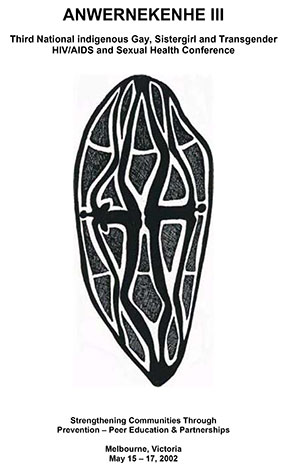 By Anwernekenhe 3, in 2002, the AFAO National Aboriginal and Torres Strait Islander Gay Men’s and Transgender Steering Committee had become known as the AFAO National Indigenous Strategic Alliance (ISA).
By Anwernekenhe 3, in 2002, the AFAO National Aboriginal and Torres Strait Islander Gay Men’s and Transgender Steering Committee had become known as the AFAO National Indigenous Strategic Alliance (ISA).
An independent review of the AFAO National Aboriginal and Torres Strait Islander Project and Steering Committee, completed in 2001, had suggested an expansion of work was needed.
A ‘whole of community’ approach was agreed to, allowing for other Aboriginal and Torres Strait Islander ‘at risk’ groups and increasing work being undertaken by AIDS Councils.
Anwernekenhe 3 highlighted some worrying emerging trends among Aboriginal and Torres Strait Islander communities such as injecting drug use and the first identified cases of HIV seroconversion in women.
In considering how best to address these issues, the ISA commenced a national organisational consultation process to canvass the idea of expanding its work.
The basis for this approach stemmed from the ISA’s belief that:6
- there were clear policy and service overlaps between what was needed for gay men and sistergirls and what was needed for other Aboriginal and Torres Strait Islander communities
- the ISA had built expertise through its work with gay men and sistergirls and this could be used to benefit other members of Aboriginal and Torres Strait Islander communities
- the ISA had already extended beyond gay men and sistergirls. Two previous projects included a treatments booklet for all Aboriginal and Torres Strait Islander people with living HIV and a project researching injecting drug use among Aboriginal and Torres Strait Islander communities
- the ISA’s links with AFAO and the different parts of the national HIV response meant they were well positioned to offer good representation to all Aboriginal and Torres Strait Islander people affected by HIV. The ISA already had a place at the table in many important parts of the mainstream national HIV response, which it could use to advocate for all Aboriginal and Torres Strait Islander communities affected by HIV.
The ensuing national consultation process provided strong support for the proposed changes. Discussions with the National Aboriginal Community Controlled Health Organisation (NACCHO) emphasised considerations around maintaining an HIV focus.
At Anwernekenhe 4, held in April 2006, two strategic ideas were presented to participants for consultation and consideration.
The first was to expand work beyond gay men and sistergirls and to respond to the needs of other Aboriginal and Torres Strait Islander people who find themselves at risk of HIV. This included:
- women and young people
- people who inject drugs
- people who engage in sex work or sex for favours
- people in custodial settings, and
- mobile/transient populations.
The second proposal was to establish an independent Aboriginal and Torres Strait Islander-controlled organisation solely focused on building and maintaining a comprehensive and effective response to HIV among Aboriginal and Torres Strait Islander communities.
Anwernekenhe 4: April 2006
 Anwernekenhe 4 deliberations endorsed the strategic change. This represented a major turning point and much hard work followed to bring this to fruition.
Anwernekenhe 4 deliberations endorsed the strategic change. This represented a major turning point and much hard work followed to bring this to fruition.
In 2008, we became incorporated as the Anwernekenhe National Aboriginal and Torres Strait Islander HIV/AIDS Alliance.
In 2009 we became the twelfth organisational member of AFAO, and secured a place on the AFAO Board alongside to other national HIV peaks.
The first Anwernekenhe conference had set many goals, and many had been achieved over the years. But to finally have a strong, independent and incorporated Aboriginal and Torres Strait Islander voice on HIV was a great outcome — it was the realisation of a dream first described at Anwernekenhe 1.
Under no illusions, we recognised that much of the hard work was still to come.
In 2006, the Department of Health and Ageing’s Office of Aboriginal and Torres Strait Islander Health (OATSIH), changed funding to a tender process, resulting in a shift of the funds.
From that point AFAO then directly funded the AFAO Aboriginal and Torres Strait Islander project and the ANA.
At the end of 2010, with limited funding opportunities, the ANA faced the real possibility of winding up the organisation.
The ANA Board in partnership with AFAO management initiated discussions with the AIDS Trust of Australia (ATA), successfully securing a grant to implement Anwernekenhe 5.
Anwernekenhe 5: August 2011
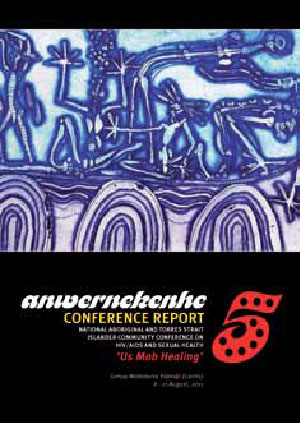 Anwernekenhe 5 saw the development of the first ever ANA Strategic Plan, providing 11 strategic goals to guide the organisation between 2011 and 2015.
Anwernekenhe 5 saw the development of the first ever ANA Strategic Plan, providing 11 strategic goals to guide the organisation between 2011 and 2015.
Soon after the conference, the ANA also received welcome news of a further grant from the ATA, allowing employment of the ANA Executive Officer.
In April 2013, the ANA then received further exciting news that the ANA would receive a three year contract through the Commonwealth Department of Health.
The contract and funding have allowed the ANA to consolidate implementation of the strategic plan and development of Anwernekenhe 6.
Anwernekenhe 6: November 2015
With the sun setting and in view of Yeperenye, Ntyarlke and Utnerrengatye7 Arrernte Elders and Custodians welcomed just over 100 people to country in Alice Springs, for Anwernekenhe 6.
After the welcoming, Neville Fazulla, Chair of the ANA and Anwernekenhe 1 participant delivered the conference chair’s address: ‘Remembering Our Journey’.
The conference program commenced with a screening of video footage8 filmed at the inaugural Anwernekenhe 1 conference.
The video stirred up strong emotions among the Anwernekenhe 6 participants.
The screening allowed us the space to remember those who were not present and to reflect on the work still to be done.
Some people spoke about the need to maintain ‘a fire in the belly’ – a sense of unity and drive needed to continue the work begun by the Anwernekenhe 1 pioneers in forming a strong community voice calling for action on HIV among Aboriginal and Torres Strait Islander communities.
A rapturous standing ovation was given to Associate Professor James Ward after delivering a passionate Anwernekenhe 6 conference keynote address.
In no uncertain terms, James outlined the potential for further increases in HIV diagnoses among Aboriginal and Torres Strait Islander people and the appalling rates of sexually transmissible infections (STIs).
His keynote address was a mix of hard data and emotion, and a strong call to the Commonwealth to implement the actions set out in the National Aboriginal and Torres Strait Islander BBV’s and STI’s Strategy 2014–2017.
James’ speech opened and closed with poignant tributes to Aboriginal and Torres Strait Islander HIV advocates, past and present, with a heartfelt tribute to community members lost to HIV and AIDS.
Anwernekenhe 6 conference participants included Aboriginal and Torres Strait Islander peer groups of people living with HIV, gay men, sistergirls, brotherboys, sex workers and people who inject drugs, alongside approximately 30 sexual health workers – all coming together to discuss, debate and share experiences about the direct impacts of HIV.
Priority issues focused on awareness, prevention, testing, treatments, care and support and stigma and discrimination.
Through these deliberations, participants actively contributed to the development of the ANA’s second Strategic Plan 2015–2019, setting out a series of priority actions.
The conference closed with presentations encapsulating the conference theme of remembering, recognising and responding.
Elders Aunty Matilda House and Aunty Joan Lamont warmly shared personal and collective stories, remembering loved ones, and historical and cultural events.
AFAO Policy and Communications Manager Linda Forbes gave a strong speech on the enduring partnership that has existed between AFAO and the ANA since Anwernekenhe 1.
Neville Fazulla acknowledged the hard and dedicated work of Aboriginal and Torres Strait Islander sexual health and community peer workers, noting that the important impact their work has had on the health and wellbeing of Aboriginal and Torres Strait Islander people. Read extracts from Neville’s speech.
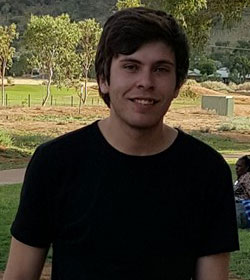 ANTHYM’s Caleb Nichols-Mansell delivered the closing statement at Anwernekenhe 6. Photo: Stephen Morgan.
ANTHYM’s Caleb Nichols-Mansell delivered the closing statement at Anwernekenhe 6. Photo: Stephen Morgan.
Fittingly, the final conference presentation came from youth representative, Caleb Nichols-Mansell.
Caleb delivered a statement on behalf of ANTHYM (the Aboriginal Nations Torres Strait Islands HIV Youth Mob), looking to the future and advocating for increased inclusion and representation of youth in responding to HIV:
‘In opening, I would like to acknowledge those elders and seniors who have paved the way and thank them for their tireless work in this sphere.
So where to from here? Mentorship is needed from Elders and seniors to empower us youth, so that we can carry on the legacy and work that has been done by those before us. Ensuring those who have already paved the way feel confident in us youth carrying on this movement into the future.
Our communities need youth to be included in the discussion around key issues in policy that affect us youth. This includes all peer groups from LGBTI, sistergirls and brotherboys, to injecting drug users and those people that are living with HIV.
It’s important we’re involved in these discussions and decision making, so that all of us in the community – including Elders – understand the issues we face. We need to work together to formulate effective strategies in prevention and awareness to cover emerging issues for our communities.
In closing I’d just like to say, us youth need to learn from our Elders just as much as they need to learn from us. We’re ready and waiting – we are the present and we are the future.’
ANA social event and community awards
Following the tradition of every other Anwernekenhe conference, with business completed it was time for the conference closing social event, featuring several well-known drag personalities in attendance.
Conference goers and many Alice Springs locals were entertained with a jam packed drag show extravaganza.
Hosted by Miss Ruby Royal Reserve, the night seemed to just slip away with numbers from Destiny Haz Arrived, Deena Deadly, Townsville Tracey and Queen of the Nullarbor.
Music by DJ Corey (who also doubled as the Conference Coordinator) ensured a fun and energetic night was had by all.
The closing social event included the ANA acknowledgment awards in recognition of work and commitment to Aboriginal and Torres Strait Islander communities and HIV.
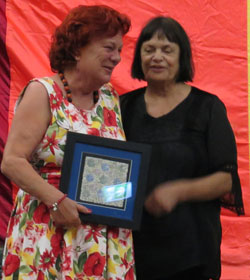 Bev Greet receiving the 2015 Rodney Junga-Williams Memorial Award,
Bev Greet receiving the 2015 Rodney Junga-Williams Memorial Award,
presented by Joan Lamont
(Rodney’s mother).
With Anwernekenhe 6 marking 21 years, special recognition awards were presented to all past Chairs of the previous and present ANA committees and Board.
The ANA Chairs over the past 21 years included: Colin Ross; Robert (Vanessa) Smith; Gary Lee; Mark Saunders; Dion Tatow; Michael Costello-Czok; Michelle Tobin; and current Chair, Neville Fazulla.
Two inaugural memorial awards were established and will be awarded biannually, the Rodney Junga-Williams Memorial Award and the John Cross Memorial Award.
The 2015 Rodney Junga-Williams Memorial Award was presented to Bev Greet.
 Rodney died in 2011, having dedicated many years to the fight for addressing treatment, care and support issues for Aboriginal and Torres Strait Islander people living With HIV, through leadership and both national and international activism.
Rodney died in 2011, having dedicated many years to the fight for addressing treatment, care and support issues for Aboriginal and Torres Strait Islander people living With HIV, through leadership and both national and international activism.
The 2015 John Cross Memorial Award was presented to Gary Lee. John Cross died in April 1995 aged 32. His vision and energy were instrumental in the development of Anwernekenhe 1, a long held dream he shared with fellow advocates.
References
1 Participants statement in Anwernekenhe 1 conference report. Anwernekenhe. (1994). Anwernekenhe First National Aboriginal and Torres Strait Islander Gay men and Transgender Sexual Health Conference. Anwernekenhe, 9.
2 Vision statement of the Anwernekenhe National HIV Alliance (ANA). For further information see: www.ana.org.au
3 Anwernekenhe. (1994). op. cit.
4 ibid.
5 Lee, G. (1988). The National Indigenous Gay and Transgender Consultation Report and Sexual Health Strategy. AFAO, Sydney.
6 Indigenous Strategic Alliance (ISA), AFAO. (2003). ISA and AFAO Strategic Directions Consultation Paper. ISA, AFAO, Sydney.
7 Yeperenye, Ntyarlke and Utnerrengatye are referred to as the giant caterpillars, the creative ancestors of Mparntwe (Alice Springs) and the Arrernte peoples.
8 A film made by Hedimo Santana in 1994. Anwernekenhe 1. (1994).
Michael Costello-Czok is Executive Officer of the Anwernekenhe National HIV Alliance (ANA) and a guest editor of HIV Australia.
Neville Fazulla is Chair of the ANA.

